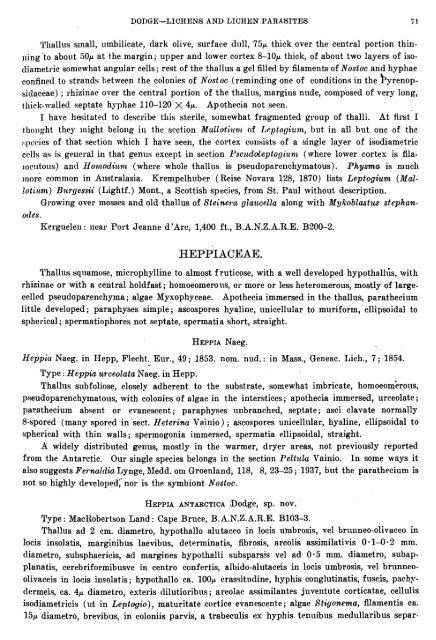Create successful ePaper yourself
Turn your PDF publications into a flip-book with our unique Google optimized e-Paper software.
DODGE-<strong><strong>LICHEN</strong>S</strong> <strong>AND</strong> <strong>LICHEN</strong> <strong>PARASITES</strong> i 1<br />
Tllallus small, umbilicate, dark olive, surface dull, 75r, thick over the central portion thiniling'to<br />
about 5OP at the margin; upper and lower cortex 8-lor, thick, of about two layers of isocliametric<br />
somewhat angular cells; rest of the thallus a gel filled by filaments of Nostoc and hyphae<br />
eonfined to strands between the colonies of Nostoc (reminding one of conditions in the byrenopsiclaceae)<br />
; rhizinae over the central portion of the thallus, margins nude, composed of very long,<br />
thick-\\-allecl septate hyphae 110-120 X 4r,. Apothecia not seen.<br />
I hare hesitated to describe this sterile, sumewhat fragmented g.1-oup of thalli. At first'I<br />
tholight they inight belong it1 the section Mulloti~rrr~ of T,cptogium, but in all but onc of the<br />
:;pcc.ies of that section which I have seen, the cortex consists of a single layer of isodiametric<br />
cells as is general in that genus except in section I-'seudoleptogicin~ (where lower cortex is filaiue!itous)<br />
an? IIon~dknt (where whole thallus is pseudopareiichymatous). Physma is mucll<br />
inore common in Australasia. Krempelhuber (Reise Novara 128, 1870) lists Leptogium (Mal,<br />
lotiwm) Bwrgessii (Lightf.) Mont., a Scottish species, from St. Paul without description.<br />
Growing over mosses and old thallus of Steinern glazccella along with itllykotoblastus stephamodes.<br />
Iiergueleii: near Port Jeanne d'Arc, 1,400 ft., B.A.N.Z.A.R.E. B200-2.<br />
HEPPIACEAE.<br />
Thallns squamose, microphylline to almost f ruticose, with a well developed hypothall;s, with<br />
rhizinae or with a central holdfast; homoeomerous, or more or less heteromerous, mostly of large-<br />
celled pseudoparenchyma ; algge Myxophyceae. Apothecia immersed in the thallus, parathecium<br />
little developed ; paraphyses simple ; ascospores hyaline, unicellular to muriform, ellipsoidal to<br />
spherical; spermatiophores not septate, spermatia short, straight.<br />
HEPPIA Naeg.<br />
Heppiu Naeg. in Hepp, Flecht. - Enr., 49; 1853. nom. nud.: in Mass., Geneac. Lich., 7; 1854.<br />
Type : Heppia zirceolata Naeg. in Hepp.<br />
Thallus subfoliose, closely adherent to the substrate, somewhat imbricate, homoeomkrous,<br />
pseudoparenchymatous, with colonies of algae in the interstices; apothecia immersed, urceolate ;<br />
parathecium absent or evanescent ; paraphyses unbranched, septate ; asci clavate normally<br />
8-spored (many spored in 'sect. Heterim Vainio) ; ascospores unicellular, hyaline, ellipsoidal to<br />
spherical with thin walls; spermogonia immersed, spermatia ellipsoidal, straight.<br />
A widely distributed genus, mostly in the warmer, dryer areas, not previously reported<br />
from the Antarctic. Our single species belongs in the section Peltule Vainio. In some ways it<br />
also suggests Pernuldia Lynge, &dd. on1 Greenland, 118, 8, 23-25 ; 1937, but the parathecium is<br />
not so highly developed:nor is the symbiont Nostoc.<br />
HEPPIA ANTARCTICA Dodge, sp. nov.<br />
Type : MacRobertson Land : Cape Bruce, B.A.N.Z.B.R.E. B103-3.<br />
Thallus ad 2 cm. diametro, hypothallo alutaceo in locis umbrosis, vel brmlneo-olivacco in<br />
locis insolatis, marginibus laevibus, determinatis, fibrosis, areolis assimilativis 0-1-0-2 mm.<br />
diametro, subsphaericis, ad margines hypothalli subsparsis vel ad 0.5 mm. diametro, snbapplanatis,<br />
cerebriformibusve in centro confertis, albido-alutaceis in locis umbrosis, vel brunneoolivaceis<br />
in locis insolatis; hypothallo ca. 10OP crassitudine, hyphis conglutinatis, fuscis, pschydermeis,<br />
ca. 4p diametro, exteris dilutiorib~~s ; areolae assimilantes jnventute corticatae, cellulis<br />
isodiametricis (ut in Leptogio) , maturitate cortice evanescente ; algae Btiyonema, filamentis ca.<br />
15r, diametro, brevibus, in coloniis parvis, a trabeculis ex hyphis tennibus mcdullaribus separ-

















